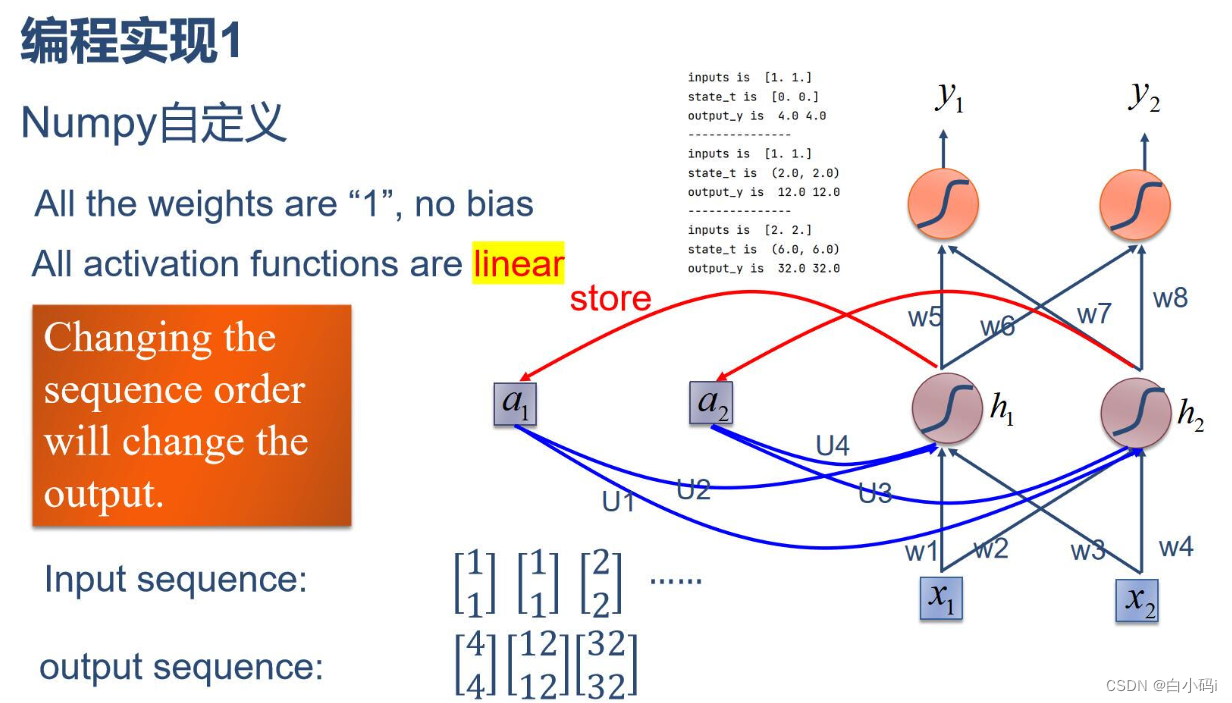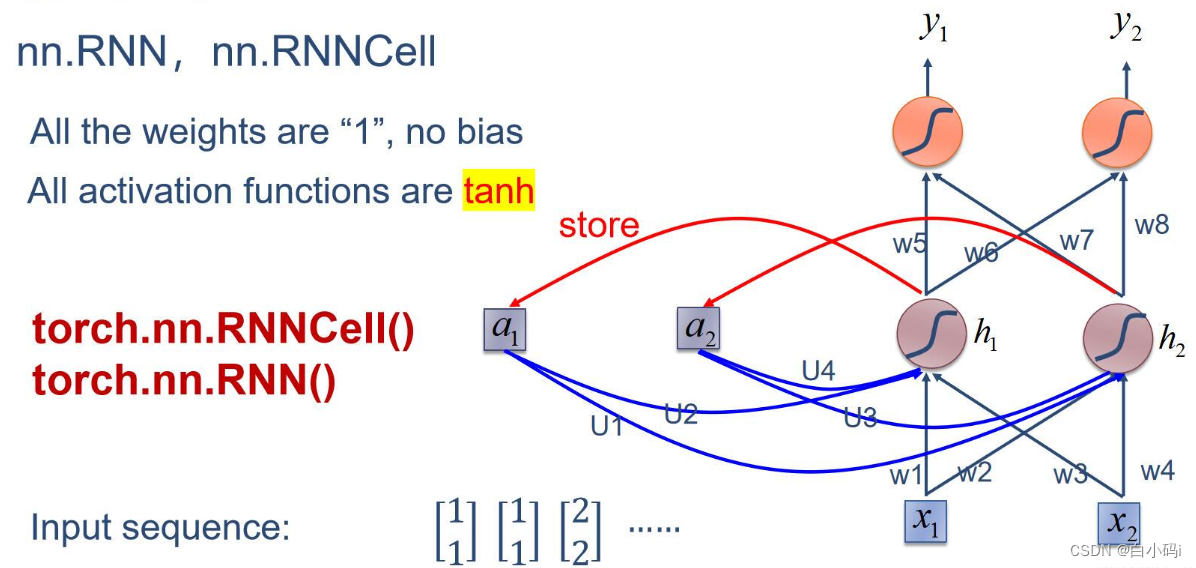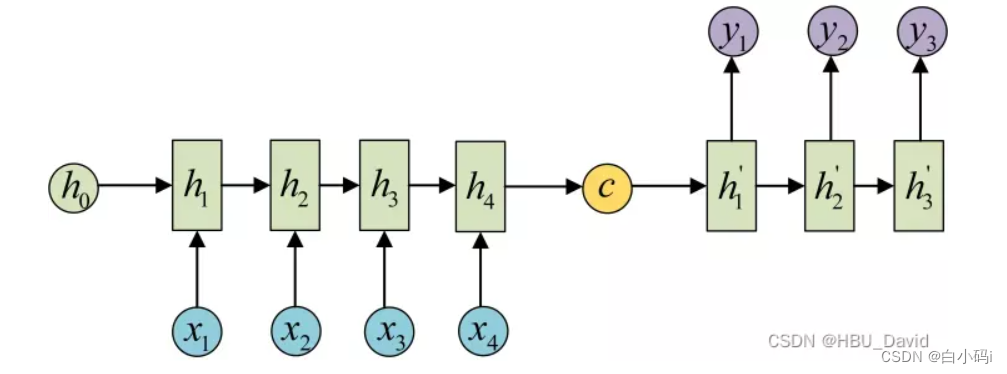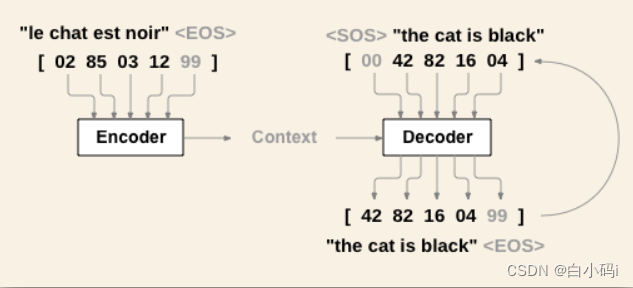简单循环网络(Simple Recurrent Network,SRN)是只有一个隐藏层的神经网络。
目录
5、实现“Character-Level Language Models”源代码
1、使用Numpy实现SRN

代码实现:
import numpy as np
inputs = np.array([[1., 1.],
[1., 1.],
[2., 2.]]) # 初始化输入序列
print('inputs is ', inputs)
state_t = np.zeros(2, ) # 初始化存储器
print('state_t is ', state_t)
w1, w2, w3, w4, w5, w6, w7, w8 = 1., 1., 1., 1., 1., 1., 1., 1.
U1, U2, U3, U4 = 1., 1., 1., 1.
print('--------------------------------------')
for input_t in inputs:
print('inputs is ', input_t)
print('state_t is ', state_t)
in_h1 = np.dot([w1, w3], input_t) + np.dot([U2, U4], state_t)
in_h2 = np.dot([w2, w4], input_t) + np.dot([U1, U3], state_t)
state_t = in_h1, in_h2
output_y1 = np.dot([w5, w7], [in_h1, in_h2])
output_y2 = np.dot([w6, w8], [in_h1, in_h2])
print('output_y is ', output_y1, output_y2)
print('---------------')运行结果:
inputs is [[1. 1.]
[1. 1.]
[2. 2.]]
state_t is [0. 0.]
--------------------------------------
inputs is [1. 1.]
state_t is [0. 0.]
output_y is 4.0 4.0
---------------
inputs is [1. 1.]
state_t is (2.0, 2.0)
output_y is 12.0 12.0
---------------
inputs is [2. 2.]
state_t is (6.0, 6.0)
output_y is 32.0 32.0
---------------Process finished with exit code 0
2、在1的基础上,增加激活函数tanh

代码实现:
import numpy as np
inputs = np.array([[1., 1.],
[1., 1.],
[2., 2.]]) # 初始化输入序列
print('inputs is ', inputs)
state_t = np.zeros(2, ) # 初始化存储器
print('state_t is ', state_t)
w1, w2, w3, w4, w5, w6, w7, w8 = 1., 1., 1., 1., 1., 1., 1., 1.
U1, U2, U3, U4 = 1., 1., 1., 1.
print('--------------------------------------')
for input_t in inputs:
print('inputs is ', input_t)
print('state_t is ', state_t)
in_h1 = np.tanh(np.dot([w1, w3], input_t) + np.dot([U2, U4], state_t))
in_h2 = np.tanh(np.dot([w2, w4], input_t) + np.dot([U1, U3], state_t))
state_t = in_h1, in_h2
output_y1 = np.dot([w5, w7], [in_h1, in_h2])
output_y2 = np.dot([w6, w8], [in_h1, in_h2])
print('output_y is ', output_y1, output_y2)
print('---------------')运行结果:
inputs is [[1. 1.]
[1. 1.]
[2. 2.]]
state_t is [0. 0.]
--------------------------------------
inputs is [1. 1.]
state_t is [0. 0.]
output_y is 1.9280551601516338 1.9280551601516338
---------------
inputs is [1. 1.]
state_t is (0.9640275800758169, 0.9640275800758169)
output_y is 1.9984510891336251 1.9984510891336251
---------------
inputs is [2. 2.]
state_t is (0.9992255445668126, 0.9992255445668126)
output_y is 1.9999753470497836 1.9999753470497836
---------------
3、分别使用nn.RNNCell、nn.RNN实现SRN

代码实现:
import torch
batch_size = 1
seq_len = 3 # 序列长度
input_size = 2 # 输入序列维度
hidden_size = 2 # 隐藏层维度
output_size = 2 # 输出层维度
# RNNCell
cell = torch.nn.RNNCell(input_size=input_size, hidden_size=hidden_size)
# 初始化参数 https://zhuanlan.zhihu.com/p/342012463
for name, param in cell.named_parameters():
if name.startswith("weight"):
torch.nn.init.ones_(param)
else:
torch.nn.init.zeros_(param)
# 线性层
liner = torch.nn.Linear(hidden_size, output_size)
liner.weight.data = torch.Tensor([[1, 1], [1, 1]])
liner.bias.data = torch.Tensor([0.0])
seq = torch.Tensor([[[1, 1]],
[[1, 1]],
[[2, 2]]])
hidden = torch.zeros(batch_size, hidden_size)
output = torch.zeros(batch_size, output_size)
for idx, input in enumerate(seq):
print('=' * 20, idx, '=' * 20)
print('Input :', input)
print('hidden :', hidden)
hidden = cell(input, hidden)
output = liner(hidden)
print('output :', output)运行结果:
==================== 0 ====================
Input : tensor([[1., 1.]])
hidden : tensor([[0., 0.]])
output : tensor([[1.9281, 1.9281]], grad_fn=<AddmmBackward0>)
==================== 1 ====================
Input : tensor([[1., 1.]])
hidden : tensor([[0.9640, 0.9640]], grad_fn=<TanhBackward0>)
output : tensor([[1.9985, 1.9985]], grad_fn=<AddmmBackward0>)
==================== 2 ====================
Input : tensor([[2., 2.]])
hidden : tensor([[0.9992, 0.9992]], grad_fn=<TanhBackward0>)
output : tensor([[2.0000, 2.0000]], grad_fn=<AddmmBackward0>)
import torch
batch_size = 1
seq_len = 3
input_size = 2
hidden_size = 2
num_layers = 1
output_size = 2
cell = torch.nn.RNN(input_size=input_size, hidden_size=hidden_size, num_layers=num_layers)
for name, param in cell.named_parameters(): # 初始化参数
if name.startswith("weight"):
torch.nn.init.ones_(param)
else:
torch.nn.init.zeros_(param)
# 线性层
liner = torch.nn.Linear(hidden_size, output_size)
liner.weight.data = torch.Tensor([[1, 1], [1, 1]])
liner.bias.data = torch.Tensor([0.0])
inputs = torch.Tensor([[[1, 1]],
[[1, 1]],
[[2, 2]]])
hidden = torch.zeros(num_layers, batch_size, hidden_size)
out, hidden = cell(inputs, hidden)
print('Input :', inputs[0])
print('hidden:', 0, 0)
print('Output:', liner(out[0]))
print('--------------------------------------')
print('Input :', inputs[1])
print('hidden:', out[0])
print('Output:', liner(out[1]))
print('--------------------------------------')
print('Input :', inputs[2])
print('hidden:', out[1])
print('Output:', liner(out[2]))运行结果:
Input : tensor([[1., 1.]])
hidden: 0 0
Output: tensor([[1.9281, 1.9281]], grad_fn=<AddmmBackward0>)
--------------------------------------
Input : tensor([[1., 1.]])
hidden: tensor([[0.9640, 0.9640]], grad_fn=<SelectBackward0>)
Output: tensor([[1.9985, 1.9985]], grad_fn=<AddmmBackward0>)
--------------------------------------
Input : tensor([[2., 2.]])
hidden: tensor([[0.9992, 0.9992]], grad_fn=<SelectBackward0>)
Output: tensor([[2.0000, 2.0000]], grad_fn=<AddmmBackward0>)
5、实现“Character-Level Language Models”源代码

翻译Character-Level Language Models 相关内容
Okay, so we have an idea about what RNNs are, why they are super exciting, and how they work. We’ll now ground this in a fun application: We’ll train RNN character-level language models. That is, we’ll give the RNN a huge chunk of text and ask it to model the probability distribution of the next character in the sequence given a sequence of previous characters. This will then allow us to generate new text one character at a time.
好的,我们对RNN是什么已经有了一定的条件,以及为什么他们这么优秀,和他们是怎样工作的,下面我们来围绕一个有趣的应用我们训练RNN模型,我们给RNN一块文章并且询问模型在这句中下个单词的的句子通过上一个字母来判断,这就允许我们每次一个字母形成一个新的文章。
As a working example, suppose we only had a vocabulary of four possible letters “helo”, and wanted to train an RNN on the training sequence “hello”. This training sequence is in fact a source of 4 separate training examples: 1. The probability of “e” should be likely given the context of “h”, 2. “l” should be likely in the context of “he”, 3. “l” should also be likely given the context of “hel”, and finally 4. “o” should be likely given the context of “hell”.
我们举一个例子,我们有一个单词是helo,并且想要训练一个RNN模型寻连hello,这个训练的序列是由四个单独的训练例子担任的,第一个字母e应该由h来给出,l应该由he来给出,l应该由hel来给出,最后一个o应该由hell给出。
Concretely, we will encode each character into a vector using 1-of-k encoding (i.e. all zero except for a single one at the index of the character in the vocabulary), and feed them into the RNN one at a time with the step function. We will then observe a sequence of 4-dimensional output vectors (one dimension per character), which we interpret as the confidence the RNN currently assigns to each character coming next in the sequence.
我们将每个字母进行独热编码(每个向量只有一个为1,其余为0,并且用RNN对每一步进行训练,我们将会观测出一个四个维度的输出向量代表每个字母),我们用RNN去判断出每个字母。
import numpy as np
import random
# utils.py中定义了本次实验所需要的辅助函数
# 包括朴素RNN的前向/反向传播 和我们在上一个实验中实现的差不多
from utils import *
data = open('D:/dinos.txt', 'r').read() # 读取dinos.txt中的所有恐龙名字 read()逐字符读取 返回一个字符串
data= data.lower() # 把所有名字转为小写
chars = list(set(data)) # 得到字符列表并去重
print(chars) # 'a'-'z' '\n' 27个字符
data_size, vocab_size = len(data), len(chars)
print('There are %d total characters and %d unique characters in your data.' % (data_size, vocab_size))
char_to_ix = { ch:i for i,ch in enumerate(sorted(chars))}
ix_to_char = { i:ch for i,ch in enumerate(sorted(chars))}
print(ix_to_char)
def softmax(x):
e_x = np.exp(x - np.max(x)) # 首先对输入做一个平移 减去最大值 使其最大值为0 再取exp 避免指数爆炸
return e_x / e_x.sum(axis=0)
def smooth(loss, cur_loss):
return loss * 0.999 + cur_loss * 0.001
def print_sample(sample_ix, ix_to_char):
'''
得到采样的索引对应的字符
sample_ix:采样字符的索引
ix_to_char:索引到字符的映射字典
'''
txt = ''.join(ix_to_char[ix] for ix in sample_ix) # 连接成字符串
txt = txt[0].upper() + txt[1:] # 首字母大写
print('%s' % (txt,), end='')
def get_initial_loss(vocab_size, seq_length):
return -np.log(1.0 / vocab_size) * seq_length
def initialize_parameters(n_a, n_x, n_y):
"""
用小随机数初始化模型参数
Returns:
parameters -- Python字典包含:
Wax -- 与输入相乘的权重矩阵, 维度 (n_a, n_x)
Waa -- 与之前隐藏状态相乘的权重矩阵, 维度 (n_a, n_a)
Wya -- 与当前隐藏状态相乘用于产生输出的权重矩阵, 维度(n_y,n_a)
ba -- 计算当前隐藏状态的偏置参数 维度 (n_a, 1)
by -- 计算当前输出的偏置参数 维度 (n_y, 1)
"""
np.random.seed(1)
Wax = np.random.randn(n_a, n_x) * 0.01
Waa = np.random.randn(n_a, n_a) * 0.01
Wya = np.random.randn(n_y, n_a) * 0.01
b = np.zeros((n_a, 1))
by = np.zeros((n_y, 1))
parameters = {"Wax": Wax, "Waa": Waa, "Wya": Wya, "b": b, "by": by}
return parameters
# GRADED FUNCTION: clip
def clip(gradients, maxValue):
'''
把每个梯度值剪切到 minimum 和 maximum之间.
Arguments:
gradients -- Python梯度字典 包含 "dWaa", "dWax", "dWya", "db", "dby"
maxValue -- 每个大于maxValue或小于-maxValue的梯度值 被设置为该值
Returns:
gradients -- Python梯度字典 包含剪切后的切度
'''
# 取出梯度字典中存储的梯度
dWaa, dWax, dWya, db, dby = gradients['dWaa'], gradients['dWax'], gradients['dWya'], gradients['db'], gradients[
'dby']
# 对每个梯度[dWax, dWaa, dWya, db, dby]进行剪切
for gradient in [dWax, dWaa, dWya, db, dby]:
# gradient[gradient>maxValue] = maxValue
# gradient[gradient<-maxValue] = -maxValue
np.clip(gradient, -maxValue, maxValue, out=gradient)
gradients = {"dWaa": dWaa, "dWax": dWax, "dWya": dWya, "db": db, "dby": dby}
return gradients
# GRADED FUNCTION: sample
def sample(parameters, char_to_ix, seed):
"""
根据朴素RNN输出的概率分布对字符序列进行采样
Arguments:
parameters --Python字典 包含模型参数 Waa, Wax, Wya, by, and b.
char_to_ix -- Python字典 把每个字符映射为索引
seed -- .
Returns:
indices -- 包含采样字符索引的列表.
"""
# 得到模型参数 和相关维度信息
Waa, Wax, Wya, by, b = parameters['Waa'], parameters['Wax'], parameters['Wya'], parameters['by'], parameters['b']
vocab_size = by.shape[0] # 字典大小 输出单元的数量
n_a = Waa.shape[1] # 隐藏单元数量
# Step 1: 创建第一个时间步骤上输入的初始向量 初始化序列生成
x = np.zeros((vocab_size, 1))
# Step 1': 初始化a_prev
a_prev = np.zeros((n_a, 1))
# 保存生成字符index的列表
indices = []
# 检测换行符, 初始化为 -1
idx = -1
# 在每个时间步骤上进行循环.在每个时间步骤输出的概率分布上采样一个字符
# 把采样字典的index添加到indices中. 如果达到50个字符就停止 (说明模型训练有点问题)
# 用于终止无限循环 模型如果训练的不错的话 在遇到换行符之前不会达到50个字符
counter = 0
newline_character = char_to_ix['\n'] # 换行符索引
while (idx != newline_character and counter != 50): # 如果生成的字符不是换行符且循环次数小于50 就继续
# Step 2: 对x进行前向传播 公式(1), (2) and (3)
a = np.tanh(Wax.dot(x) + Waa.dot(a_prev) + b) # (n_a,1)
z = Wya.dot(a) + by # (n_y,1)
y = softmax(z) # (n_y,1)
np.random.seed(counter + seed)
# Step 3:从输出的概率分布y中 采样一个字典中的字符索引
idx = np.random.choice(range(vocab_size), p=y.ravel())
indices.append(idx)
# Step 4: 根据采样的索引 得到对应字符的one-hot形式 重写输入x
x = np.zeros((vocab_size, 1))
x[idx] = 1
# 更新a_prev
a_prev = a
seed += 1
counter += 1
if (counter == 50):
indices.append(char_to_ix['\n'])
return indices
def rnn_step_forward(parameters, a_prev, x):
'''朴素RNN单元的前行传播'''
# 从参数字典中取出参数
Waa, Wax, Wya, by, b = parameters['Waa'], parameters['Wax'], parameters['Wya'], parameters['by'], parameters['b']
# 计算当前时间步骤上的隐藏状态
a_next = np.tanh(np.dot(Wax, x) + np.dot(Waa, a_prev) + b)
# 计算当前时间步骤上的预测输出 通过一个输出层(使用softmax激活函数,多分类 ,类别数为字典大小)
p_t = softmax(np.dot(Wya, a_next) + by)
return a_next, p_t
def rnn_step_backward(dy, gradients, parameters, x, a, a_prev):
'''朴素RNN单元的反向传播'''
gradients['dWya'] += np.dot(dy, a.T)
gradients['dby'] += dy
da = np.dot(parameters['Wya'].T, dy) + gradients['da_next'] # backprop into h
daraw = (1 - a * a) * da # backprop through tanh nonlinearity
gradients['db'] += daraw
gradients['dWax'] += np.dot(daraw, x.T)
gradients['dWaa'] += np.dot(daraw, a_prev.T)
gradients['da_next'] = np.dot(parameters['Waa'].T, daraw)
return gradients
def update_parameters(parameters, gradients, lr):
'''
使用随机梯度下降法更新模型参数
parameters:模型参数字典
gradients:对模型参数计算的梯度
lr:学习率
'''
parameters['Wax'] += -lr * gradients['dWax']
parameters['Waa'] += -lr * gradients['dWaa']
parameters['Wya'] += -lr * gradients['dWya']
parameters['b'] += -lr * gradients['db']
parameters['by'] += -lr * gradients['dby']
return parameters
def rnn_forward(X, Y, a0, parameters, vocab_size=27):
'''
朴素RNN的前行传播
和上一个实验实验的RNN有所不同,之前我们一次处理m个样本/序列 要求m个序列有相同的长度
本次实验的RNN,一次只处理一个样本/序列(名字单词) 所以不用统一长度。
X -- 整数列表,每个数字代表一个字符的索引。 X是一个训练样本 代表一个单词
Y -- 整数列表,每个数字代表一个字符的索引。 Y是一个训练样本对应的真实标签 为X中的索引左移一位
'''
# Initialize x, a and y_hat as empty dictionaries
x, a, y_hat = {}, {}, {}
a[-1] = np.copy(a0)
# initialize your loss to 0
loss = 0
for t in range(len(X)):
# 设置x[t]为one-hot向量形式.
# 如果 X[t] == None, 设置 x[t]=0向量. 设置第一个时间步骤的输入为0向量
x[t] = np.zeros((vocab_size, 1)) # 设置每个时间步骤的输入向量
if (X[t] != None):
x[t][X[t]] = 1 # one-hot形式 索引位置为1 其余为0
# 运行一步RNN前向传播
a[t], y_hat[t] = rnn_step_forward(parameters, a[t - 1], x[t])
# 得到当前时间步骤的隐藏状态和预测输出
# 把预测输出和真实标签结合 计算交叉熵损失
loss -= np.log(y_hat[t][Y[t], 0])
cache = (y_hat, a, x)
return loss, cache
def rnn_backward(X, Y, parameters, cache):
'''朴素RNN的反向传播'''
# Initialize gradients as an empty dictionary
gradients = {}
# Retrieve from cache and parameters
(y_hat, a, x) = cache
Waa, Wax, Wya, by, b = parameters['Waa'], parameters['Wax'], parameters['Wya'], parameters['by'], parameters['b']
# each one should be initialized to zeros of the same dimension as its corresponding parameter
gradients['dWax'], gradients['dWaa'], gradients['dWya'] = np.zeros_like(Wax), np.zeros_like(Waa), np.zeros_like(Wya)
gradients['db'], gradients['dby'] = np.zeros_like(b), np.zeros_like(by)
gradients['da_next'] = np.zeros_like(a[0])
### START CODE HERE ###
# Backpropagate through time
for t in reversed(range(len(X))):
dy = np.copy(y_hat[t])
dy[Y[t]] -= 1
gradients = rnn_step_backward(dy, gradients, parameters, x[t], a[t], a[t - 1])
### END CODE HERE ###
return gradients, a
# GRADED FUNCTION: optimize
def optimize(X, Y, a_prev, parameters, learning_rate=0.01):
"""
执行一步优化过程(随机梯度下降,一次优化使用一个训练训练).
Arguments:
X -- 整数列表,每个数字代表一个字符的索引。 X是一个训练样本 代表一个单词
Y -- 整数列表,每个数字代表一个字符的索引。 Y是一个训练样本对应的真实标签 为X中的索引左移一位
a_prev -- 上一个时间步骤产生的隐藏状态
parameters -- Python字典包含:
Wax -- 与输入相乘的权重矩阵, 维度 (n_a, n_x)
Waa -- 与之前隐藏状态相乘的权重矩阵, 维度 (n_a, n_a)
Wya -- 与当前隐藏状态相乘用于产生输出的权重矩阵, 维度 (n_y, n_a)
ba -- 计算当前隐藏状态的偏置参数 维度 (n_a, 1)
by -- 计算当前输出的偏置参数 维度 (n_y, 1)
learning_rate -- 学习率
Returns:
loss -- loss函数值(交叉熵)
gradients -- python dictionary containing:
dWax -- Gradients of input-to-hidden weights, of shape (n_a, n_x)
dWaa -- Gradients of hidden-to-hidden weights, of shape (n_a, n_a)
dWya -- Gradients of hidden-to-output weights, of shape (n_y, n_a)
db -- Gradients of bias vector, of shape (n_a, 1)
dby -- Gradients of output bias vector, of shape (n_y, 1)
a[len(X)-1] -- 最后一个隐藏状态 (n_a, 1)
"""
# 通过时间前向传播
loss, cache = rnn_forward(X, Y, a_prev, parameters, vocab_size=27)
# 通过时间的反向传播
gradients, a = rnn_backward(X, Y, parameters, cache)
# 梯度剪切 -5 (min) 5 (max)
gradients = clip(gradients, maxValue=5)
# 更新参数
parameters = update_parameters(parameters, gradients, lr=learning_rate)
return loss, gradients, a[len(X) - 1]
# GRADED FUNCTION: model
def model(data, ix_to_char, char_to_ix, num_iterations=35000, n_a=50, dino_names=7, vocab_size=27):
"""
训练模型生成恐龙名字.
Arguments:
data -- 文本语料(恐龙名字数据集)
ix_to_char -- 从索引到字符的映射字典
char_to_ix -- 从字符到索引的映射字典
num_iterations -- 随机梯度下降的迭代次数 每次使用一个训练样本(一个名字)
n_a -- RNN单元中的隐藏单元数
dino_names -- 采样的恐龙名字数量
vocab_size -- 字典的大小 文本语料中不同的字符数
Returns:
parameters -- 训练好的参数
"""
# 输入特征向量x的维度n_x, 输出预测概率向量的维度n_y 2者都为字典大小
n_x, n_y = vocab_size, vocab_size
# 初始化参数
parameters = initialize_parameters(n_a, n_x, n_y)
# 初始化loss (this is required because we want to smooth our loss, don't worry about it)
loss = get_initial_loss(vocab_size, dino_names)
# 得到所有恐龙名字的列表 (所有训练样本).
with open("D:/dinos.txt") as f:
examples = f.readlines() # 读取所有行 每行是一个名字 作为列表的一个元素
examples = [x.lower().strip() for x in examples] # 转换小写 去掉换行符
# 随机打乱所有恐龙名字 所有训练样本
np.random.seed(0)
np.random.shuffle(examples)
# 初始化隐藏状态为0
a_prev = np.zeros((n_a, 1))
# 优化循环
for j in range(num_iterations):
# 得到一个训练样本 (X,Y)
index = j % len(examples) # 得到随机打乱后的一个名字的索引
X = [None] + [char_to_ix[ch] for ch in examples[index]] # 把名字中的每个字符转为对应的索引 第一个字符为None翻译为0向量
Y = X[1:] + [char_to_ix['\n']]
# 随机梯度下降 执行一次优化: Forward-prop -> Backward-prop -> Clip -> Update parameters
# 学习率 0.01
curr_loss, gradients, a_prev = optimize(X, Y, a_prev, parameters, learning_rate=0.01)
# 使用延迟技巧保持loss平稳. 加速训练
loss = smooth(loss, curr_loss)
# 每2000次随机梯度下降迭代, 通过sample()生成'n'个字符(1个名字) 来检查模型是否训练正确
if j % 2000 == 0:
print('Iteration: %d, Loss: %f' % (j, loss) + '\n')
seed = 0
for name in range(dino_names): # 生成名字的数量
# 得到采样字符的索引
sampled_indices = sample(parameters, char_to_ix, seed)
# 得到索引对应的字符 生成一个名字
print_sample(sampled_indices, ix_to_char)
seed += 1 # To get the same result for grading purposed, increment the seed by one.
print('\n')
return parameters
parameters = model(data, ix_to_char, char_to_ix) # 训练模型每个矩形都是一个向量,箭头表示函数(例如矩阵乘法)。输入向量为红色,输出向量为蓝色,绿色向量保持 RNN 的状态。从左到右:(1)没有RNN的普通处理模式,从固定大小的输入到固定大小的输出(例如图像分类)。(二)序列输出(例如,图像字幕获取图像并输出单词句子)。(三)序列输入(例如,将给定句子归类为表达积极或消极情绪的情感分析)。(四)序列输入和序列输出(例如机器翻译:RNN 用英语阅读一个句子,然后用法语输出一个句子)。(五)同步序列输入和输出(例如,我们希望标记视频每一帧的视频分类)。请注意,在每种情况下,长度序列都没有预先指定的约束,因为循环变换(绿色)是固定的,可以根据需要多次应用。
7、“编码器-解码器”的简单实现

# Model
class Seq2Seq(nn.Module):
def __init__(self):
super(Seq2Seq, self).__init__()
self.encoder = nn.RNN(input_size=n_class, hidden_size=n_hidden, dropout=0.5) # encoder
self.decoder = nn.RNN(input_size=n_class, hidden_size=n_hidden, dropout=0.5) # decoder
self.fc = nn.Linear(n_hidden, n_class)
def forward(self, enc_input, enc_hidden, dec_input):
# enc_input(=input_batch): [batch_size, n_step+1, n_class]
# dec_inpu(=output_batch): [batch_size, n_step+1, n_class]
enc_input = enc_input.transpose(0, 1) # enc_input: [n_step+1, batch_size, n_class]
dec_input = dec_input.transpose(0, 1) # dec_input: [n_step+1, batch_size, n_class]
# h_t : [num_layers(=1) * num_directions(=1), batch_size, n_hidden]
_, h_t = self.encoder(enc_input, enc_hidden)
# outputs : [n_step+1, batch_size, num_directions(=1) * n_hidden(=128)]
outputs, _ = self.decoder(dec_input, h_t)
model = self.fc(outputs) # model : [n_step+1, batch_size, n_class]
return model
model = Seq2Seq().to(device)
criterion = nn.CrossEntropyLoss().to(device)
optimizer = torch.optim.Adam(model.parameters(), lr=0.001)
使用Pytorch复现Seq2Seq,Seq2Seq网络结构:

具体代码实现:
首先导库,用 'S' 作为开始标志,'E' 作为结束标志,如果输入或者输入过短,使用 '?' 进行填充
# code by Tae Hwan Jung(Jeff Jung) @graykode, modify by wmathor
import torch
import numpy as np
import torch.nn as nn
import torch.utils.data as Data
device = torch.device('cuda' if torch.cuda.is_available() else 'cpu')
# S: Symbol that shows starting of decoding input
# E: Symbol that shows starting of decoding output
# ?: Symbol that will fill in blank sequence if current batch data size is short than n_step定义数据集以及参数
n_step保存的是最长单词的长度,其它所有不够这个长度的单词,都会在其后用 '?' 填充
letter = [c for c in 'SE?abcdefghijklmnopqrstuvwxyz']
letter2idx = {n: i for i, n in enumerate(letter)}
seq_data = [['man', 'women'], ['black', 'white'], ['king', 'queen'], ['girl', 'boy'], ['up', 'down'], ['high', 'low']]
# Seq2Seq Parameter
n_step = max([max(len(i), len(j)) for i, j in seq_data]) # max_len(=5)
n_hidden = 128
n_class = len(letter2idx) # classfication problem
batch_size = 3下面是对数据进行处理,主要做的是,首先对单词长度不够的,用 '?' 进行填充;然后将 Deocder 的输入数据末尾添加终止标志 'E',Decoder 的输入数据开头添加开始标志 'S',Decoder 的输出数据末尾添加结束标志 'E'
def make_data(seq_data):
enc_input_all, dec_input_all, dec_output_all = [], [], []
for seq in seq_data:
for i in range(2):
seq[i] = seq[i] + '?' * (n_step - len(seq[i])) # 'man??', 'women'
enc_input = [letter2idx[n] for n in (seq[0] + 'E')] # ['m', 'a', 'n', '?', '?', 'E']
dec_input = [letter2idx[n] for n in ('S' + seq[1])] # ['S', 'w', 'o', 'm', 'e', 'n']
dec_output = [letter2idx[n] for n in (seq[1] + 'E')] # ['w', 'o', 'm', 'e', 'n', 'E']
enc_input_all.append(np.eye(n_class)[enc_input])
dec_input_all.append(np.eye(n_class)[dec_input])
dec_output_all.append(dec_output) # not one-hot
# make tensor
return torch.Tensor(enc_input_all), torch.Tensor(dec_input_all), torch.LongTensor(dec_output_all)
'''
enc_input_all: [6, n_step+1 (because of 'E'), n_class]
dec_input_all: [6, n_step+1 (because of 'S'), n_class]
dec_output_all: [6, n_step+1 (because of 'E')]
'''
enc_input_all, dec_input_all, dec_output_all = make_data(seq_data)由于这里有三个数据要返回,所以需要自定义DataSet,具体来说就是继承torch.utils.data.Dataset类,然后实现里面的_len_以及_getitem_方法
class TranslateDataSet(Data.Dataset):
def __init__(self, enc_input_all, dec_input_all, dec_output_all):
self.enc_input_all = enc_input_all
self.dec_input_all = dec_input_all
self.dec_output_all = dec_output_all
def __len__(self): # return dataset size
return len(self.enc_input_all)
def __getitem__(self, idx):
return self.enc_input_all[idx], self.dec_input_all[idx], self.dec_output_all[idx]
loader = Data.DataLoader(TranslateDataSet(enc_input_all, dec_input_all, dec_output_all), batch_size, True)下面定义 Seq2Seq 模型,注意相关参数设置
# Model
class Seq2Seq(nn.Module):
def __init__(self):
super(Seq2Seq, self).__init__()
self.encoder = nn.RNN(input_size=n_class, hidden_size=n_hidden, dropout=0.5) # encoder
self.decoder = nn.RNN(input_size=n_class, hidden_size=n_hidden, dropout=0.5) # decoder
self.fc = nn.Linear(n_hidden, n_class)
def forward(self, enc_input, enc_hidden, dec_input):
# enc_input(=input_batch): [batch_size, n_step+1, n_class]
# dec_inpu(=output_batch): [batch_size, n_step+1, n_class]
enc_input = enc_input.transpose(0, 1) # enc_input: [n_step+1, batch_size, n_class]
dec_input = dec_input.transpose(0, 1) # dec_input: [n_step+1, batch_size, n_class]
# h_t : [num_layers(=1) * num_directions(=1), batch_size, n_hidden]
_, h_t = self.encoder(enc_input, enc_hidden)
# outputs : [n_step+1, batch_size, num_directions(=1) * n_hidden(=128)]
outputs, _ = self.decoder(dec_input, h_t)
model = self.fc(outputs) # model : [n_step+1, batch_size, n_class]
return model
model = Seq2Seq().to(device)
criterion = nn.CrossEntropyLoss().to(device)
optimizer = torch.optim.Adam(model.parameters(), lr=0.001)下面是训练,由于输出的 pred 是个三维的数据,所以计算 loss 需要每个样本单独计算,因此就有了下面 for 循环的代码
for epoch in range(5000):
for enc_input_batch, dec_input_batch, dec_output_batch in loader:
# make hidden shape [num_layers * num_directions, batch_size, n_hidden]
h_0 = torch.zeros(1, batch_size, n_hidden).to(device)
(enc_input_batch, dec_intput_batch, dec_output_batch) = (enc_input_batch.to(device), dec_input_batch.to(device), dec_output_batch.to(device))
# enc_input_batch : [batch_size, n_step+1, n_class]
# dec_intput_batch : [batch_size, n_step+1, n_class]
# dec_output_batch : [batch_size, n_step+1], not one-hot
pred = model(enc_input_batch, h_0, dec_intput_batch)
# pred : [n_step+1, batch_size, n_class]
pred = pred.transpose(0, 1) # [batch_size, n_step+1(=6), n_class]
loss = 0
for i in range(len(dec_output_batch)):
# pred[i] : [n_step+1, n_class]
# dec_output_batch[i] : [n_step+1]
loss += criterion(pred[i], dec_output_batch[i])
if (epoch + 1) % 1000 == 0:
print('Epoch:', '%04d' % (epoch + 1), 'cost =', '{:.6f}'.format(loss))
optimizer.zero_grad()
loss.backward()
optimizer.step()下面进行测试
# Test
def translate(word):
enc_input, dec_input, _ = make_data([[word, '?' * n_step]])
enc_input, dec_input = enc_input.to(device), dec_input.to(device)
# make hidden shape [num_layers * num_directions, batch_size, n_hidden]
hidden = torch.zeros(1, 1, n_hidden).to(device)
output = model(enc_input, hidden, dec_input)
# output : [n_step+1, batch_size, n_class]
predict = output.data.max(2, keepdim=True)[1] # select n_class dimension
decoded = [letter[i] for i in predict]
translated = ''.join(decoded[:decoded.index('E')])
return translated.replace('?', '')
print('test')
print('man ->', translate('man'))
print('mans ->', translate('mans'))
print('king ->', translate('king'))
print('black ->', translate('black'))
print('up ->', translate('up'))运行结果:
Epoch: 1000 cost = 0.002630
Epoch: 1000 cost = 0.002464
Epoch: 2000 cost = 0.000522
Epoch: 2000 cost = 0.000545
Epoch: 3000 cost = 0.000170
Epoch: 3000 cost = 0.000156
Epoch: 4000 cost = 0.000055
Epoch: 4000 cost = 0.000056
Epoch: 5000 cost = 0.000020
Epoch: 5000 cost = 0.000019
test
man -> women
mans -> women
king -> queen
black -> white
up -> down
在测试过程中,Decoder 的 input 是没有意义占位符,所占位置的长度即最大长度n_step





















 7151
7151











 被折叠的 条评论
为什么被折叠?
被折叠的 条评论
为什么被折叠?








